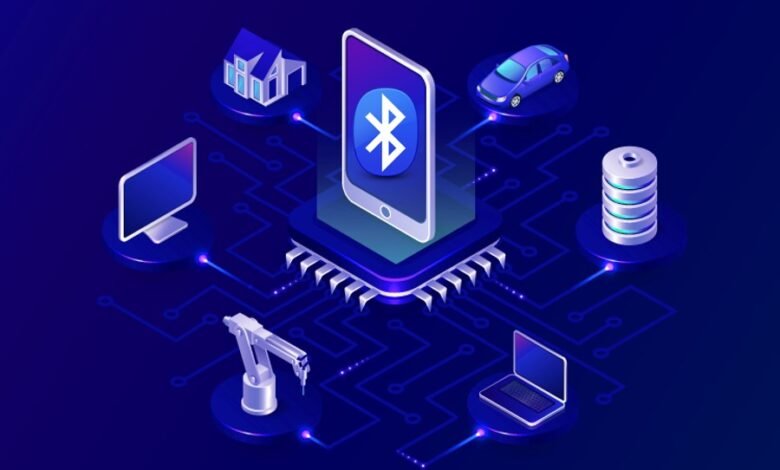Bluetooth App Development in IoT: What Developers Need to Know
Bluetooth and the creation of its apps make short-range communication safe and low-power, which makes them perfect for many Internet of Things (IoT) uses.

As the Internet of Things (IoT) keeps growing, Bluetooth technology has become an important part of making devices that can talk to each other. Bluetooth and the creation of its apps make short-range communication safe and low-power, which makes them perfect for many Internet of Things (IoT) uses.
This article will talk about the most important things IoT developers need to know about Bluetooth app development in IoT, such as what they are, how they work, the problems they can face, the safest ways to do things, and what the future holds.
Important of Bluetooth in IoT Applications
Bluetooth technology is important for IoT apps because it is widely used, doesn’t use much power, and is reliable. It makes it possible for devices close together to talk to each other, which is important for smart homes, personal tech, and industrial automation.
Because Bluetooth works with so many devices, developers have been able to make IoT solutions that are flexible and easy for users to use. These solutions improve connectivity and usefulness.
Bluetooth Low Energy (BLE) has also made IoT applications more useful by providing a more energy-efficient option that lets devices run for longer amounts of time on smaller power sources. This is especially important for uses where battery life is very important, like smart appliances, wearable health devices, and environmental sensors. BLE makes sure that devices stay linked and send data reliably without using up a lot of power quickly. This is why it is a key part of many connected solutions.
IoT communities are easier to set up because Bluetooth works with a lot of different platforms and devices. Bluetooth’s standardized protocols make it easy for different devices to talk to each other, which helps the growth of scalable and flexible IoT systems. For example, they make it possible for sensors to join in a smart city network and for health monitoring to happen in real time.
Bluetooth is a key device for the growing Internet of Things because it is easy to connect and most people already know how to use it.
Key Bluetooth Protocols and Standards
IoT developers need to know a lot about Bluetooth protocols and standards. Because it works well and uses little power, Bluetooth Low Energy (BLE) is very important for Internet of Things (IoT) apps. BLE is made to send data on a regular basis, which is popular in IoT settings.
Other important standards are Bluetooth Classic, which is used for streaming media like music, and Bluetooth Mesh, which lets a lot of devices connect to a network, making contact more reliable and extending the range.
In addition to these standards, Bluetooth 5.0 and later versions have added a lot of new features that make it easier to use IoT devices.
Bluetooth 5.0 has longer range, faster data transfer rates, and better broadcasting features. This makes it perfect for smart home systems, connected medical devices, and IoT uses in the workplace. With these improvements, Bluetooth 5.0 makes IoT ecosystems work better by making connections stronger and more reliable over longer distances. This is important for both individual and business IoT environments.
Common Problems and Potential Solutions in Bluetooth App Development in IoT
It can be hard to make Bluetooth applications for IoT devices, but developers can get past problems like interference, limited range, and not being able to connect to other devices by using the right techniques.
Interference from other wireless signals

Solutions: Developers can use advanced algorithms that prioritize Bluetooth traffic and filter out noise from competing wireless technologies like Wi-Fi or Zigbee to deal with interference from signals that overlap. These algorithms help keep the link stable, so IoT devices can talk to each other reliably even when there are a lot of other devices around.
Limited range
Solutions: You can get around Bluetooth’s built-in range problems by using range extenders or setting up Bluetooth Mesh networking. By relaying signals between nodes, mesh networking lets more Bluetooth devices talk to each other over longer distances. This means that devices spread out over a big area can still keep strong, reliable connections without performance dropping.
Making Sure That All Devices and Systems Can Work Together
Solution: For developers to make sure that their apps work with all kinds of devices and systems, they need to use standard Bluetooth protocols like Bluetooth Low Energy (BLE) and Bluetooth 5.0. By following these rules, developers make sure that their apps work the same way on all devices, operating systems, and hardware setups. This lowers the chance that users will have problems connecting or the apps not running properly.
Best Practices for Safeguarding Bluetooth Communication
In Bluetooth communication and app development, particularly within IoT applications handling sensitive data, prioritizing security is essential. By adhering to critical best practices, developers can protect data transmission and minimize the risk of breaches.
- Implement robust encryption: Employ strong encryption protocols, such as AES-128, to secure data during transmission, ensuring sensitive information remains inaccessible to unauthorized entities.
- Ensure device authentication: Require mutual device authentication before data exchange to prevent unauthorized access and establish a secure connection.
- Regularly update firmware and software. Keep Bluetooth devices and applications up-to-date with the latest security patches to mitigate known vulnerabilities and strengthen overall protection.
- Use secure pairing methods: Implement secure pairing protocols, like Just Works or Passkey Entry, to restrict connections to trusted devices only.
- Conduct thorough security audits: Regularly audit the Bluetooth communication infrastructure for potential vulnerabilities and confirm adherence to current security standards and best practices.
Future Trends in Bluetooth Technology for IoT
Bluetooth technology is changing quickly to keep up with the needs of IoT uses in many different fields. IoT ecosystems are getting more complicated, and Bluetooth is changing to offer better security, speed, and scalability.
Bluetooth technology is about to change the way devices talk to each other and connect, which will make it better for both home and business use. The following are a few of the most important advances.
Bluetooth 5.1
One of the most important new features in Bluetooth 5.1 is its direction-finding feature, which lets devices figure out exactly where a signal source is. People who use indoor navigation, asset tracking, and smart buildings will find this function very useful. Bluetooth 5.1 can correctly pinpoint the location of connected devices by using Angle of Arrival (AoA) and Angle of Departure (AoD) methods. This makes it an important tool for industries that need precise positioning. This progress makes it possible for more advanced IoT uses, like automated product management in warehouses or personalized shopping experiences for customers in stores.
Advancements in Bluetooth Mesh Networking

Bluetooth mesh networking is getting better all the time, which is another big trend in the future of Bluetooth technology for IoT. Mesh networking, unlike standard point-to-point Bluetooth connections, lets many devices talk to each other. It does this by connecting many devices together and sending data over longer distances by passing it through nodes in the network. This is especially helpful for big IoT projects like smart cities, industrial control systems, or lots of smart building networks.
Increased Focus on Energy Efficiency
As Internet of Things (IoT) devices become more common, Bluetooth technology will need to be able to use less energy. A lot of IoT devices run on batteries and need to be able to go for a long time without being charged often. There have already been big steps forward in lowering power use with Bluetooth Low Energy (BLE), but newer forms of Bluetooth are likely to go even further. Better power management and faster data rates will make it possible for IoT devices to work more efficiently, which will increase battery life without lowering performance.
Security Enhancements for IoT Applications
As the number of IoT devices grows, Bluetooth protection becomes even more important. IoT is expected to connect billions of gadgets, and each link in the chain of communication could be a security hole. As Bluetooth technology develops in the future, it will continue to focus on improving security procedures to keep private data safe and IoT systems safe from cyber threats.
Conclusion
Bluetooth technology is still a key part of developing IoT apps because it makes connections reliable and easy. It is possible for IoT developers to get the most out of Bluetooth in their projects by knowing how important it is for app development, getting to know key protocols, solving development problems, and following best security practices.
As Bluetooth technology changes, developers will need to keep up with the newest trends and improvements in order to make new, safe IoT solutions.










